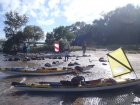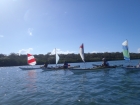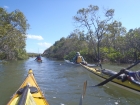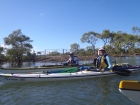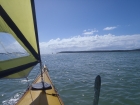Ever since Ray took us to Pancake Creek as an also-ran to a 2005 Keppels trip, we have been wanting to return. It was not until now, more than a decade later, we finally got there.
26 May – Arrival at Middle Creek
With three vehicles travelling different distances the plan was to meet between 1300 and 1330 at the 1770 boat ramp where the LARC launches. This was made redundant by being hard to be incognito and a tight locality. Robin and Trevor found us first having morning tea at Reedy Creek Reserve, a Bush Heritage site recommended by Agnes Water Visitors Information Centre. This transpired into a delightful short walk where Melaleuca quinquinervia are festooned with an exquisite cloak of Lygodium microphyllum (Climbing Maiden Hair Fern). We cut short our walk along the Discovery Trail at Agnes Waters to head over to 1770. We met again, this time with the full crew at the top of the hill at 1770.
With no need for the boat ramp it was back down the hill to covet a parking space. Trevor and Robin went for a $17.70 pub lunch while Graham, Mark and I had a picnic in the park. The day was warm, the outlook sparkling. Dusty 4WD bearing a range of state plates suggested people had come from far and wide – little wonder, 1770 is a quaint (slightly crowded) piece of paradise.
Having seen what 25Kn SE looks like south of Bustard Head, the key was planning for the tide to allow backwater access from Middle to Pancake Creek via the causeway. According to Kerry Middle Creek Bar is a surf landing best attempted towards the top of an incoming tide. Less of the the white stuff and a favourable drift provides grace for any swimmers to float with their boat to camp.
With assurance from the Ranger the track was in “good condition” and flanked by vehicles advertisers spruik, we took the RAV off road, probably for its first time. The drive into Eurimbula National Park disappears into an open woodland forest. Trunks of evenly spaced trees with mottled scaly bark emerged from a fine haze of tall lime green grasses. These discretely reduced to a neatly mown carpet which erupted into fountains of xanthorrea. The gravel became sand, the track narrowed and wended through rainforest. The RAV handled well for a suburban shopping basket.
Compared with the drive in, Middle Creek Camping Ground was underwhelming. It did have a toilet, fire pits, plenty of scrub turkeys and an encampment of fishermen. The best place for the view and breeze (for midge clearance) was high on a bald hill – taken by an impressive 4WD camper. Graham, Mark and I elected to get our feet wet to take a look at the mouth of Middle Creek. Despite the calm conditions, there were plenty of breaking waves and without a birds eye view, hard to determine an optimum approach.
Tonight’s meal was a communal one. Nibbles were biscuits with double brie and a soft blue cheese, a main of spaghetti bolognese followed by sticky date pudding with warm toffee sauce, toasted marshmallows and port. The fire continued to burn despite being encircled by the peak of the Spring Tide. Robin’s tent came periously close to those creeping salty fingers. Moments after a comment on a passing cloud the evening was bought to an abrupt close by the dash of rain. The fisherman laughed to see such sport as lights darted into tents and cars.
27 May – Paddling from Middle to Pancake Creek 20km
With vehicles moved and boats packed we were ready to head upstream with the incoming tide. An indistinct left turn (there were no beer cans in the mangroves) took an apparent about face in direction of travel. Robin became edgy and his persistent questioning of Mark’s navigation was finally silenced by the sudden appearance of a large tinny coming towards us. We made good time to the causeway. Impeccable even. Right on slack water which turned out to be the same as high tide on the Gladstone Bar. Thereafter Robin was off and out front.
The flat grassy campsite Ray had chosen last time was taken by our neighbours. This left us with the stretch of beach just north of the track to Bustard Head Lighthouse. It had access from quarter tide following the inundation of the coral reef. While not a glamour shoot from a tourist mag, the reef had a variety of soft and hard corals. Many had a layer of silt. Some had a queasey colour and texture of a giant slime gob. Sprays of bait fish erupted at random and plenty of pan sized fish darted around the edge of the reef. No one was terribly keen about becoming wading bait. The afternoon was warm and the tents had dried. A couple of fly draped over a rope made for a communal camp kitchen.
28 May – Exploring Jenny Lind Creek 18km
With the peak of the high tides now falling, today was the chance to see if we could get through from Pancake to Jenny Lind via Chinaman Creek. Robin and Trevor went ahead looking for the creek referred to by our neighbours yesterday afternoon. Graham, Mark and I called into the large campsite close to where the yachts moor. Marked by a straight row of palms on the foreshore this large flat site was flanked by a marsh at the rear and had a walking track to Aircraft Beach (1.8Km) and the Lighthouse (2.6Km). It had little to recommend it with the exception of it’s large flat area and all tide access.
We followed the navigation Mark had created on his GPS using Google Earth. His casual comment about a mud crab to Graham was as good as a spear. Graham was out as quick as a flash, next he had Trevor’s paddle and was scooping the armoured meal up onto the bank. Picking it up by the flippers, it was promptly dispatched into his front hatch. Finders keepers are eaters.
While we were crossing the salt pan we could hear a tinny coming. Clearly familiar with the location and not used to sharing, it roared around the corner. The pro-crabber got such a surprise when he came across Robin that Mark thought he wasn’t going to take the corner. He passed looking somewhat stunned and grunted “how many more ?”. His dog gave a congruous greeting.
The channel opened to a vast expanse of shallow clear water bounded by dunes on the far side where the LARC had left tracks. Running my fingers through the sand in the shallow water at the foot of the dunes felt like crackly rice bubbles reminiscent of Mulligans Beach off Hinchinbrook. After whistling Robin across, the rest of the group pulled up in the shade of the casuarinas before heading up the dune which gave a commanding overview of the landscape that bounds Jenny Lind Creek. We skirted the so called ‘Survivor Camp’ marked by a beach volleyball net at the southern end of the next inlet. By now the tide was falling quickly and we had no option but go out via the bar. We were buzzed by a float plane as we surveyed the entrance from the northern vantage point. Any wave gives me chicken feathers, this looked like plumage. The decision was made to stay in close to the northern bank before heading out through a series of what appeared to be smaller waves. Robin was off and gone, then Trevor, I squeaked that I wanted to go next. The waves weren’t that big but big enough to get a facewash.
It was further around to the magical Aircraft Beach than I had anticipated. Apparently there are caves along the foreshore accessible at low tide. Aircraft Beach was as gorgeous as ever. The surprise find was a sign welcoming you to ‘1770 Castaway’. Tucked in the scrub at the southern end of the beach, a narrow track layered with brown pandanus fronds lead to a substantial camp site. We took up a seat at a communal table under a huge tarp which fed a rainwater tank. In the nearby bushes were four tents on wooden platforms. Fuel containers, large eskies, rubbish collection bins, plastic kayaks, inner tubes, solar equipment, kitchen utensils, the more you looked, the more there was. Someone had spent a lot of money, yet it was neglected, like it had been abandoned.
On the way back into Pancake Creek we passed by people camping at a sandy beach just in from the point at a place possibly lovelier than the one we had chosen. As tail enders we made it into the campsite at Pancake Creek with just enough water to clear the reef.
Mark, Graham and I went for a walk up to Bustard Head Lighthouse. The xanthorrea spikes were feeding stations for an exquisite array of butterflies, some of which we had never seen before. Breynia, grevillea and other familiar plants appeared when you looked for them. As we came up to the lighthouse the volunteer keepers were setting out to walk down to the caves with their son who was visiting. One keeper graciously stayed behind and took us on a tour of the lighthouse, museum and generator room. The place was immaculate and he was well versed with local knowledge. Originally the headland had been a sandy patch, not the windswept thicket of dense native flora punctuated by xanthorrea spires. It turned out the campsite at Aircraft Beach was a tourist venture that had been abandoned after one of the aircraft that used to bring people to the site had a fatal crash in January 2017.
That night muddie was dispatched with expertise. For dinner we were privileged to a magnificent meal of fish given to us that morning by our northern neighbours and cooked to perfection by Trevor.
29 May – Richards Beach 26km
Both Kerry and Patrick speak highly of Richards Beach. While it was not entirely clear which stretch of sand this was, it was enough of an incentive to spend the day exploring to the north. Small, gentle waves were forming on the sandy bar to the north of the channel at Pancake Creek. It was tempting to stop and play some more, but we were already going to be pushing the tide in both directions. Robin headed out ahead and paddled by an isolated bombora. As the shoreline started to be punctuated by granite boulders Robin headed back inshore to rock hop his way along the coast. The swell was gentle and the shore break just happening. The water was beautifully clear. After a morning tea break off a point, the coastline was forming into a repeated pattern of gently sloping custard beaches curving in from granite outcrops. It was as beautiful as quiet. Lunch was had in the shade of some casuarinas draped with fishing nets. While Mark and I were keen to go beyond the next point, our enthusiasm was not shared. We took the return leg as an opportunity to explore the shoreline to the north of Pancake Creek.
30 May – Return via Middle Creek 25km
By now I was all for spending another night at Pancake Creek, if for no other reason than to play in the small swell on the incoming tide the next morning. The conditions had been so favorable that even I was starting to consider returning to Middle Creek via the front. The decision was for Huey to adjudicate. The prediction of a 15-20Kn SE had my plumage on display. There was no way I wanted to bash into a headwind all morning and then attempt to cross a shallow bar in a laden boat. Certainly not when there is a sneaky creek alternative.
As the high tide had just edged of the small fire on the beach, I poured the washing up water on the ashes and to everyone’s surprise it erupted like a volcano. The heat in the sand was phenomenal. 20L later it finally stopped spitting ash with another 20L poured over it for good measure. Although there was no push for time, Trevor did not like the prospect of being the last kayak packed.
It started out as a dull grey overcast morning. We called into the campsite on the southern edge of Pancake Creek. It was a dreary place marked by a palm tree and remnants of a fire scattered with cans and rusty tins. Robin and Trevor cast a line, while Graham, Mark and I used the incoming tide to explore some of the creeks which, on a king tide are rumoured to give access across Rodds Peninsular. The channel became quite narrow and had a rocky outcrops lurking in the mud. It was unclear how easy they would be to navigate with another metre of water. The mangroves were pristine and had Graham salivating for a return trip with a tinny. No slides were seen, but with such mild conditions they can’t be too many years away. When we returned Trevor had a pan sized trevally in his day hatch which Robin hooked using a plastic lure.
After lunch at the causeway perched on the rusted hulk of a punt, Mark took us into the channel which Robin had wanted to follow to keep the SWER line in sight. As it wended around going nowhere in particular it became very shallow. Before long it time to get out before the tide dropped any further. The wind that had filled our sails on the way up Middle Creek now blew at us. Nevertheless, with the receding tide we made similar time and were soon nudging the kayaks up on the firm sand at Middle Creek. The scrub turkeys were out in force and soon clattering around in the back of Trev’s camp kitchen on the tray back of his ute. We enjoyed another meal and toasted marshmallows in front of a camp fire. The tide left this fire alone and although the rain stayed away a heavy dew saturated the tents.
31 May – Return Home
Trevor and Robin headed off to Eurimbula National Park campsite. We followed Graham using the UHF radio for oncoming traffic reports and to keep a look out for the likes of emus. As soon as we pulled into the campsite it was clear why Graham would prefer to tow his camper here than stay at 1770. Glorious waterfront views, plenty of shade, well laid out sites serviced with toilets, water tanks, fire rings and large open shelters with picnic tables. A mere 5Km paddle from 1770 – no 4WD necessary.
With a full day’s drive ahead of them, both Trevor and Robin and Graham were soon on their way back to Brisbane. Woodgate was our destination, so we returned to complete the headland walk at Agnes Waters. We called into Baffle Creek. Can’t say it did much for either of us, neither did Rules Beach whose slope was similar to that of Palm Beach by Coonar. Rules looked like it was about to succumb to house lots. We have since learned that the beach to the north or Rules Beach is well worth a visit.
Little wonder both Kerry and Patrick have a special affection for the coastline around Pancake Creek. I look forward to returning for a chance to camp at Eurimbula Camp Ground, the site near the mouth of Pancake Creek, play in the tiny surf, take a yabbi pump to supply bait for those keen on fishing, walk to the caves at the foot of Bustard Head Lighthouse, explore beyond Richards Point, and, if the tide is right consider a paddle across Rodds Peninsular. Something to do before 2029 or the crocs move in – any takers ?
2005 Pancake Ck
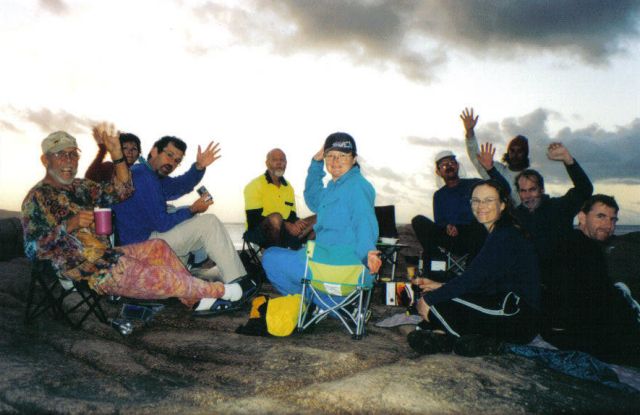
Tracks and Maps
Google Maps Directions to Middle Ck from Brisbane City
Map images

